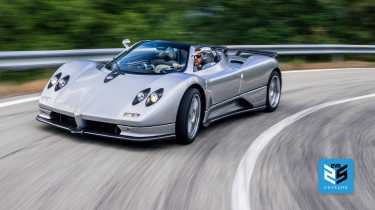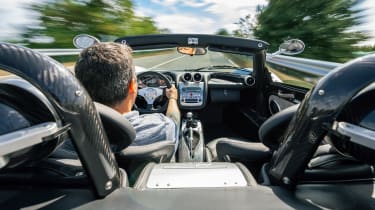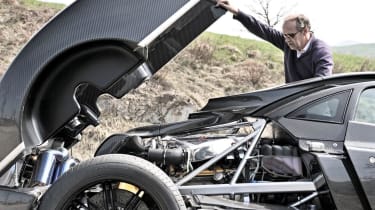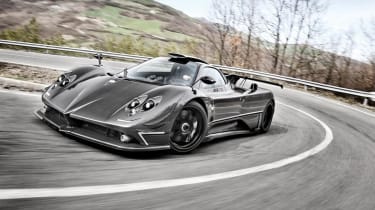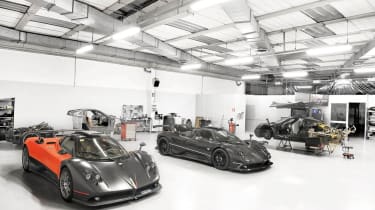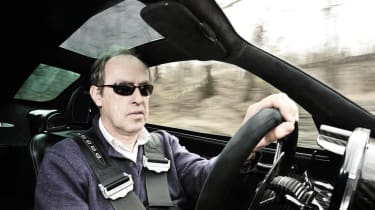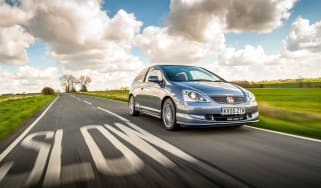Pagani Zonda (1999 - 2019): the analogue supercar icon
Pagani's first and most iconic model changed the supercar game on its arrival, making it one of our top 25 cars of the last 25 years
Life is good when you have the key to a Pagani Zonda tucked in your pocket. It’s a feeling we got to know very well at evo over the years, thanks to many visits to Pagani’s factory in San Cesario sul Panaro, and, of course, the utterly surreal period when Harry Metcalfe’s sensational C12‑S regularly sat outside evo Towers.
It’s a happy coincidence that both Pagani and evo were founded in 1998. Our paths wouldn’t cross until March of 1999, when the Zonda C12 was launched at the Geneva motor show. Weirdly, few people seemed to pick up on it, but, curious about a new supercar that looked like nothing else and came from a company we’d never heard of, we stepped onto the show stand to find out more.
> The Pagani Huayra R Evo is an 888bhp, 9200rpm roofless hypercar
We were greeted by a Brit by the name of Mike Perry. Steeped in the supercar scene, Mike had been sales and marketing manager at Lamborghini London in the mid-to-late ’80s and was now working for Pagani as a PR and marketing consultant. It was he who introduced us to – and translated for – a quietly spoken man by the name of Horacio Pagani.
More reviews
Mike sadly passed away in 2020, but the connection he made that day remains an enduring highlight of the last 25 years. A month or so after that first meeting in Geneva we flew out to Modena to meet Mike for a tour of the Pagani factory. There we took a closer look at the Zonda, spent a few days with Horacio and met some of the people he had gathered around him to realise his dream. Amongst them was another modestly brilliant man by the name of Loris Bicocchi – a test driver and engineer Horacio had known at Lamborghini, and to whom he entrusted the dynamic development of the C12.
A few months after that first visit, we returned, this time to be amongst the first in the world (and the first UK publication) to drive the C12. It was a trip I’ll never forget. The Zonda – then in humble 6-litre specification – was Pagani’s hard-worked test and development car, but its virtuosity shone through the slightly careworn patina. It was like nothing I’d driven before.
Until this point the only V12 carbonfibre supercar of note had been the McLaren F1. Tricky to drive and dominated by its magnificent BMW motor, the glow of its golden engine bay and extraordinary Le Mans win ensured it transcended conventional critiques. Meanwhile, Lamborghini was still building the Diablo – a glorious dinosaur in its twilight years.
Judged against these two counterparts, the Zonda felt like a supersized Lotus Elise. Supple and beautifully poised, with pinpoint steering and immense performance, it gave the lie to supercar lore that demanded exotica should be belligerent and/or intimidating to drive. It didn’t (yet) have an engine to match those of the Macca or the Lambo, but Pagani’s creation put its 389bhp (yep, that’s all folks!) to sublime use.
I can still remember organising ‘The Test’ (evo 022) – a diverse supercar gathering of Ferrari 550 Maranello and 360 Modena, Porsche 996 Turbo, Chrysler Viper GTS, Diablo VT 6.0 and Zonda C12 in glorious Tuscany – the following summer. Privately, my inclusion of the Pagani made me wonder if I’d been the victim of a Jedi mind trick, but only because the Zonda was yet to receive validation from the wider motoring media.
Much to my relief it made the same impression on the rest of the evo team, though that cooking-spec Merc V12 and a rather stiff shift in the hard-worked development car’s five-speed gearbox meant our collective praise wasn’t without caveat. Still there was a palpable sense the supercar landscape had shifted slightly on its axis. Pagani was a player from the get-go.
From this point things moved fast. Just six C12s were built (five coupes and one Roadster) between 1999 and 2000 before the Zonda C12‑S, complete with 542bhp 7-litre motor, succeeded it. Sixteen such cars (all coupes) were built over the next three years, but it was an even more potent version – the Zonda S 7.3 – making its debut at Geneva in 2002 that really moved the game on, thanks to a new crankshaft, titanium con rods and a whoopier, loopier 7000rpm red line.
The second 7.3 S to be built – chassis 021 – was right-hand drive and served as Pagani’s UK demo car. That car would appear in evo on a number of occasions, most notably our ‘Supercar Heaven’ cover story for the November 2003 issue. But it was when a certain CH Metcalfe purchased the car in the spring of 2006 that evo’s relationship with the Zonda reached its zenith. Okay, in hindsight we probably did overdo the whole Pagani thing – not for nothing did evo gain the nickname What Zonda? – but then we were one of the few magazines to have privileged access to a succession of genuinely extraordinary cars.
It’s been many years – more than a decade, truth be told – since I’ve driven a Zonda. So it’s with great affection and anticipation that I head back to Modena for a nostalgic drive in a 7.3 S. Much has changed at Pagani since my last visit, a new factory, significant Saudi investment and an extraordinary rise in Zonda values foremost amongst them, but the things that matter haven’t changed a bit. Pagani remains a family business.
Sadly, Horacio Pagani is on vacation back in his native Argentina at the time of our visit, but his son Christopher (a child when I first visited) is a welcoming host. Best of all he has the keys to his father’s recently acquired 7.3-litre Zonda S Roadster. Freshly prepped, fuelled and looking pristine in silver, this exquisite all-carbon creation is mine for the day.
The passage of two decades can be cruel to once cutting-edge supercars, but the naturally aspirated Zonda, complete with six-speed stick-shift gearbox, feels timeless and epic. Apart from ABS and a rudimentary traction control system, the only dynamic modes are those controlled by your mood and prevailing conditions. Quality always stands the test of time, and those Zonda qualities that shone so brightly remain dazzling to this day.
So much of the driving experience remains unique. The flamboyant style and immaculate execution are unmatched, and the sense of being right at the pointy end of an arrowhead is still true to Pagani’s vision of a Group C racer. The meaty steering weight is appropriate, but the accuracy and consistency with which you can place this hugely wide and outwardly intimidating machine is still uncanny and unexpected.
However, it’s the colossal sense of propulsion that’s truly extraordinary. Where contemporary supercars shout and shriek, or simply spool-up and slingshot you down the road, the Zonda moves with epic elasticity, that big, free-spinning Benz V12 simmering with seismic potency. It is majestic, as only large-capacity 12-cylinder motors can be.
With just 1280kg (plus fluids and driver) to propel, it pulls like a train from tickover to limiter, the sense of enormous shove accentuated by such minimal mass. The gearbox takes a bit of mastering, especially the cross-gate upshift from second to third, but there’s so much stonk you can shred most roads using third and fourth. Working in the meat of the torque curve makes for imperious progress, with lunges into the final 2500rpm of the rev range delivering truly explosive acceleration and dizzying reach.
Early Zondas were road cars first and foremost and it shows in the way they drive. Ferociously fast when fully lit but relaxed and refined when you’re savouring the moment, they exude the kind of maturity and confidence that makes today’s hypercars seem laughably overwrought. Once driven, never forgotten.
History
To understand the Pagani Zonda, you need to understand the man behind it. The car in question does not so much fit into a supercar niche, but arguably defined the notion of a car transcending established super qualities, offering luxury and exclusivity on a new level. The Zonda was not super just in performance terms, but in its build quality, detailing and execution too. Compared to its contemporaries, the Zonda was a small town supercar, but it put many of them to shame with its attention to detail - an ethos driven by the man behind the name.
Horatio Pagani, the Argentinian born company founder, is known as the father of carbonfibre due to his breakthrough work with Lamborghini in the 1980s. Hit by a global recession in the early 90s, Lamborghini put a halt to its advanced materials research, so Pagani decided to go it alone, creating a composites research and development company with the sole purpose of funding the creation of his own supercar.
The result was the Zonda C12, a culmination of Horatio Pagani's passion for composite materials and exquisite attention to detail. Upon its launch, the Zonda C12 featured a 388bhp V12 connected to a five-speed gearbox, with only five cars built from 1999. In 2002, Pagani released a more potent C12 S, upgrading to a hand-built 7-litre with a much higher 542bhp peak power. These S models also gained an uprated 6-speed gearbox and featured subtle tweaks to the exterior styling.
After 15 units and less than a year in production, Pagani uprated the engine again to a 7.3-litre unit, only representing a 5bhp increase over the previous 7-litre, but forming the foundation for the Zonda’s numerous future iterations. Subsequent Roadster, F and Cinque models all utilised the same basic engine, each being built in extremely limited numbers and at significantly increasing prices. The Zonda’s popularity kept it in demand even beyond the launch of it’s intended successor the Huayra. To appease his most loyal customers, Horatio is still building excruciatingly expensive one-offs like the 760RS.
Engine and transmission
One of the most intuiting parts of the Pagani story is how a small Italian start up were able to get Mercedes-AMG on board in the first place. Horatio Pagani, an Argentinian national living in Italy, had reached out to five-time F1 champion Juan Manuel Fangio for a recommendation letter he required to secure his Italian residency. After striking up a personal friendship. it was Fangio that connected to this little known Italian engineer to the Mercedes-Benz corperation which would eventually power his future supercar.
As one of Mercedes-Benz’ honorary directors, Fangio's job was to convince his fellow directors to agree to an engine supply deal – arguably giving the Pagani Zonda the prestigious partner it needed to impress prospective buyers. In honour of his involvement, Pagani initially intended on calling the Zonda the Fangio F1, but decided against it after his death in 1995 in respect to the Fangio family.
The engine itself is a fairly ancient Mercedes-Benz V12 codenamed M120. It has been in production since 1991, being utilised in various Mercedes-Benz flagships in the 1990s and 2000s. But the engine that ended up in the Zonda 760RS we drove in evo issue 170 is by no means a normal Mercedes-Benz V12 engine, having undergone significant redevelopment by both AMG and Pagani engineers over the years and now built by hand exclusively for Pagani.
With a total of 749bhp at a spine-tingling 8000rpm, it is truly one of the most spectacular engines ever fitted to a car – with a combination of scintillating high rev performance underlined by a big, torquey push that you only get with a swept capacity that’s more akin to a medium sized locomotive.
The RS model we drove was saddled with a brutal 6-speed sequential gearbox, although subsequent owners - including one Lewis Hamilton – had theirs fitted with a 6-speed manual.
Suspension, steering and brakes
At its core, the Zonda is based around a carbonfibre tub (or carbo-titanium in the case of later models - that is carbonfibre laced with a strand of titanium that goes some way to alleviating carbonfibre’s natural tendency to shatter under impact). Sitting either side of the tub are extruded aluminium sub-frames, which hold the suspension and powertrain.
Connected to each are individually forged and machined wishbones, connecting to the wheel hub and carbon ceramic brake disk via a centre lock wheel nut. Each forged aluminium/magnesium alloy wheel is then machined via CNC before being painted and shod in Pirelli PZero tyres.
The sheer attention to detail lavished on the Zonda would almost justify its existence without the utterly beguiling driving experience attached, but thankfully it does both.
Interior
All the attention lavished under the skin continues in the cabin. During the design process, Horatio Pagani emphasised a fighter jet like feeling for the cockpit, granting the light filled cabin with surprisingly good visibility. This is backed up with an array of finely crafted components made from the best materials, combining milled and machined aluminium with fine leathers and perfect carbonfibre work.
The relative luxury of earlier cars was pared back in the pursuit of weight reduction for the 760 models, although this is not to be mistaken for a dive in craftsmanship. As per the owners specification, the 760RS was finished with a plethora of carbon components, with most aluminium components being finished in anodized black aluminium.
Rivals
The Pagani Zonda’s closest rivals are period hypercars like the Porsche Carrera GT and Ferrari Enzo. These were built at the height of pure internal combustion drivetrains allowing smaller boutique manufacturers like Pagani to be able to match the performance levels of the big supercar dynasties. The difference is that in the preceding years, Pagani constantly refined the package whereas rivals like Ferrari and Porsche pursued the hybrid technology that since formed the backbone of their LaFerrari and 918 Spyder hypercars.
An equally ambitious startup that appeared at roughly the same time as Pagani was Koenigsegg, mirroring Horacio in the constant refinement of a central product line. But the Koenigsegg Agera and all its subsequent variations have classically been based more on the abject of ultimate speed, lacking the fastidious attention to detail and aesthetic sentiment that has defined the Zonda from its inception.
Pagani Zonda specs
| Zonda C12 (1999) | 760RS (2012) | |
| Engine | 6-litre naturally-aspirated V12 | 7.2-litre naturally-aspirated V12 |
| Max power | 389bhp | 749bhp |
| Max torque | 420lb ft | 575lb ft |
| Transmission | Five-speed manual, rear-wheel drive | Six-speed semi-automatic, rear-wheel drive |
| Weight (dry) | 1280kg | 1210kg |
| Power/weight | 304bhp/ton | 619bhp/ton (dry) |
| 0-62mph | c4sec (claimed) | 2.6sec (claimed) |
| Top speed | c185mph (claimed) | 217mph (claimed) |
What we said
In evo issue 170, we were given an exclusive chance to drive the Zonda 760RS in the Modenese hills before the car was shipped to its owner in South America. Keep reading for one of evo’s most extraordinary experiences ever.
'Some people are never satisfied. Just ask Horacio Pagani, who was convinced that the £1.5m, 669bhp Zonda Cinque Roadster would be the last road-going Zonda the Pagani factory would ever produce. But he hadn’t counted on the degree of pestering he would receive from wealthy Pagani clientele for a road-going version of the even more extreme, but track-use only, 739bhp Zonda R.
For the ten customers who have bought a Zonda R so far, gaining access to a circuit every time they fancy going for a spin is obviously not a problem, but for the rest of the world’s supercar-buying population, you could argue that the Zonda R is a tad compromised. That’s why Horacio eventually started to consider building a Zonda R for the road and, together with a small group of equally fanatical engineers, has spent the last year developing the car you see here, the mighty Zonda 760RS – or ‘La Bestia’ (The Beast) as it’s affectionately known at Pagani.
I first got wind of this car completely by accident while visiting the Pagani factory in Modena last year. I was walking through the workshop when I spotted the well-used Zonda development car hiding in the corner. But something looked different. At first I couldn’t work out what it was, then it dawned on me: the back of the gearbox casing was protruding out of the rear valance further than normal, just like it does on a Ferrari 288 GTO. But why was there a new type of gearbox hanging out the back of this development hack? I’d understood that all Zonda development had ceased when the focus switched to bringing its successor, the Huayra, towards production reality…
After plenty of arm-twisting over the coming months, I finally got an answer. Apparently it all came about after AMG found a way of increasing the output of the 7.3-litre V12 engine it makes for the Zonda from the Cinque’s 669bhp to 750bhp (760 PS). Unbeknown to the outside world, Horacio had previously decided that if Pagani was ever to build a Zonda R for the road then the 7.3 V12 had to at least equal the 739bhp tally of the 6-litre V12 race engine fitted to the R (unfortunately that engine could never be made to work in a road car because of emissions, noise and durability issues).
With the news from AMG that 750bhp was possible, the road-going Zonda R project was given the green light and attention turned next to finding a way to speed up the gearchange of the six-speed single-clutch automated-manual gearbox (first used in the Cinque) to match that of the race-derived ’box found in the R. That’s where this new seven-speed paddle-shift ’box comes in. With new internals and so-called ‘super-synchros’, which include an internal brake to slow the gears down quicker before engaging on downshifts, it promised quicker changes (said to be just 60ms), faster acceleration and an even higher top speed. Pagani started testing this exciting new drivetrain in its development car last year. Now, 12 months later, it is putting the final touches to the very first customer car to use it.
Time for another visit to the factory. ‘La Bestia’ certainly lives up to its nickname. Clothed in glossy bare carbonfibre and finished off with matt black wheels, it looks properly menacing when I see it for the first time inside Pagani’s new factory buildings. The finish of the carbonfibre bodywork on this customer car is simply exquisite, with only silver brake calipers and an inch-wide slash of silver paint on each side (running from the front valance, along the bottom of the doors and ending just behind the rear wheels) adding some contrast to the overriding blackness.
It’s hard to know where to begin when it comes to listing the details that define this ultimate Zonda, but let’s begin with the new rear spoiler, which is a monster and perches on top of two adjustable pylons that position it even higher than the one fitted to the Cinque. It’s wider too, and sitting just in front of it is a new dorsal fin, there to smooth out the airflow over the rear wing at very high speeds. It makes the car look even more like some sort of Le Mans refugee, as does the elongated air intake snaking its way from the top of the windscreen back towards the mighty V12 engine, just visible below the rear clamshell. Move to the nose of the car and you’ll find two new winglets on the sides that deflect air away from the turbulence caused by the front wheels. At 10 inches wide, the front wheels themselves are an inch wider than those found on the Cinque, while the rears are half an inch wider at 13 inches across. The wider front wheels have necessitated new arch extensions and these are screwed in place, just like those on a Porsche 993 GT2. The only details I’m not entirely convinced by are the strange LED running lights sitting just below the front light clusters. They give the unmistakable look of a smiley face, which I’m sure wasn’t the intention.
Sitting beside the 760RS in the workshop is the travel-stained development Zonda, sporting a bare carbon nose section and an orange wrap over the rest of its bodywork, plus the same rear wing and snorkel as the customer car. Most importantly, its engine has been uprated to 760 specification. It will be this car that will give me my first taste of what a 750bhp Zonda drives like, because today’s plan is for me to drive it behind Pagani’s test driver, Davide Testi, as he takes the customer 760RS out on a shakedown drive before it’s prepped for shipping to its new owner in South America in two days’ time. Even better, I’m going to have a drive in the proper 760 too, because its very generous new owner has agreed to allow evo a drive in his new toy, which when you consider he hasn’t even seen it yet, let alone driven it, is very decent of him.
There’s nothing like the blare of two 7.3-litre V12s snorting into life to get you energised about the day ahead. The vibe of 24 cylinders champing at the bit is rattling around the garage and sounds magnificent. Inside the development car I flick the right-hand paddle to select first gear, then edge forwards and follow Davide out into the bright sunlight. The combination of two-metre-wide bodywork, a rear wing that wouldn’t look out of place at RAF Brize Norton and the most extreme rear diffuser I’ve ever seen outside the confines of a race circuit must make these Zondas look almost surreal in the dreary morning traffic around Bologna. How often do you get to see a brace of extreme Paganis flying in formation through the morning rush hour on your way to work?
As we head for the hills, the howl emanating from the sooty-black exhaust of the 760RS up front pierces the cabin of my car every time Davide floors the throttle. I try to follow suit whenever the road is clear enough, but with 750bhp under my right foot to play with, each squirt only lasts a few seconds before we catch another knot of traffic.
The punch from the revised engine feels properly strong, but trying to determine where the extra horsepower over and above the Cinque’s 669bhp really kicks in is tricky as the seven-speed gearbox has very different ratios to the six-speeder I’m more used to. The good news is I’ve got another 500rpm to play with because the engine revisions have raised the rev limit to 7500rpm. This makes a significant difference to the way you drive, because each time you change gear you’re higher up the rev-range, so acceleration is that bit stronger than it was before. I can’t wait for my go in the customer car, though. I’ve been told that it’s a remarkable 200kg lighter than the development car thanks to Pagani’s new construction techniques for the carbon body panels and also its titanium suspension components (first used on the Cinque) and trick carbo-titanium passenger cell.
Right on cue, Davide pulls into a lay-by in front of me. It’s time to swap cars. The 760RS’s door is noticeably lighter as I swing it open. The black Alcantara-covered bucket seat beckons me to climb over the chunky sill, its carbo-titanium weave glinting in the sunshine. Once I’m cocooned in the new seat (adjustable fore and aft but not for rake unless you’ve brought a spanner with you) I’m surrounded by blackness. The only bright aluminium is the steering wheel’s spokes; the rest of the dash furniture is finished in cool black anodised aluminium, which makes a real difference to this Zonda’s interior, making it appear less Versace and more Prada to my eyes. Twisting the key one notch energises the electrical systems; next you can either twist the key a bit more or press the scarlet button by the gear selector to bring the engine to life. I go for the latter (it adds to the theatre).
This car is still running the default software for the gearbox, so the changes feel a bit ponderous compared with the altogether more lively ones in the development car, but what I can sense straight away is this car’s lack of mass. With a dry weight of just 1210kg, the 760RS boasts a power-to-(dry)-weight ratio of 630bhp per ton. To put that figure into perspective, the new BMW M5 would have to have over 1100bhp hiding under its bonnet to match it.
Even though this is the most extreme road-going Zonda in existence, those same qualities that make the ‘lesser’ Zondas such easy supercars to drive are all still present. The ride remains exemplary, for example, completely defying what you would expect for something that’s so low it appears to be glued to the tarmac. And while the engine is rabidly more powerful in this latest incarnation, there’s still a truckload of torque on offer at any revs (with a peak of 575lb ft at 4500rpm), so no matter what gear you’re in, acceleration is never less than ferocious.
Yet it’s the howl that accompanies each serious prod of the accelerator that’s truly shocking. Mix the heavy V12 snarl of a Ferrari Enzo with the wail of a wrung-out superbike and you’d be only halfway to the full-blooded battle-cry this crazed Zonda creates. As we storm up a twisting, deserted road that leads to the little town of Zocca, high in the hills behind Maranello, the quad exhausts behind me crackle away on each downshift, sending a shockwave through the valley below. It’s almost like sniper fire, such is the ferocity, and with the sound reverberating off the hills, it makes me wish this drive will never end.
This latest engine upgrade adds another layer of greatness to what was already a pretty special engine. It’s not quite the giant leap over the Cinque’s 669bhp version that I was expecting, but there is a new sense of never-ending power on tap, and with the seven-speed gearbox stacking the ratios that little bit closer together, you never find yourself ‘between gears’ in the 760RS. Having said that, you rarely use sixth and seventh because they’re taller now and the gearbox won’t even allow you to select seventh unless you’re doing at least 60mph. There’s so much to enjoy in this latest version of the seemingly perennial Zonda that it’s hard to take it all in. But Zondas have always been like this. It’s Pagani’s obsession with the details that makes its cars so unique, and its engineers just can’t help themselves, adding another tweak or two if they believe it’ll add to the experience.
Is the 760 the very last Zonda? Horacio Pagani is reluctant to say either way. What we do know is that there seem to be more and more wealthy enthusiasts who want a very special Zonda for themselves. So the 760RS is branded with ‘1 of 1’, but there will be more Zondas with the 750bhp engine. The next will be called the 760LH and is being built for an F1 world champion (I’ll let you work out who that might be). Interestingly, he’s ordered his car with a manual gearbox (as has the buyer of 760 no. 3) because, and I quote, ‘My company car has a paddle-change gearbox, so when I drive for fun, I want a manual’. I like his thinking, but I’m still a big fan of the automated manual in this car because it adds another dimension to the Zonda experience.
But, whichever gearbox you choose, it’s that mad engine that dominates. Yes, the £1.5m price tag attached to a Zonda 760 is a crazy amount of money, but then the driving experience it buys is also unique. While many of today’s supercars get increasingly high-tech, the Zonda remains relatively old-school, and that, in my book, is what makes it so special.' – Harry Metcalfe, evo 170
